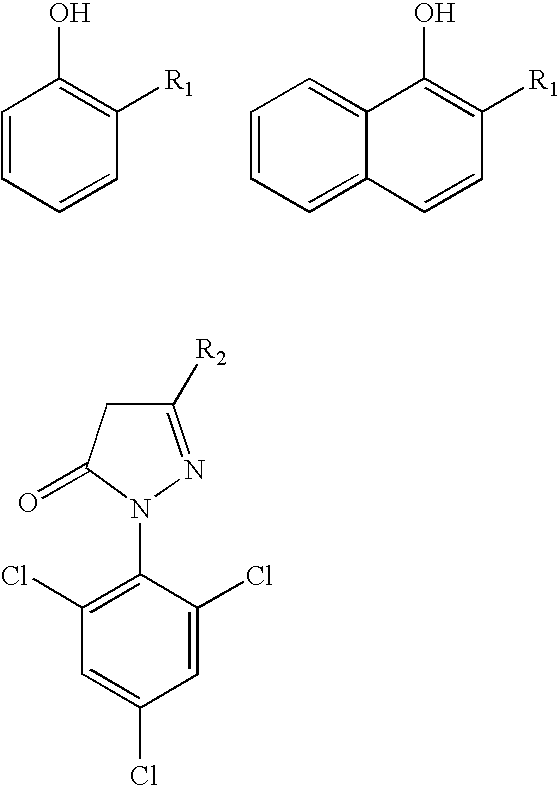Azo coupling reactions of hydrophobic compounds
a technology of hydrophobic compounds and coupling reactions, which is applied in the coupling reaction of azo dyes, organic dyes, organic chemistry, etc., can solve the problems of hazardous volatile organic compounds, high cost, foul smelling and other problems, and achieve the effect of simple and more environmentally friendly
- Summary
- Abstract
- Description
- Claims
- Application Information
AI Technical Summary
Problems solved by technology
Method used
Image
Examples
example 1
(Compound of Formula I, from Diazonium D1, and Coupler C1
[0029] To the diazonium salt D1 solution prepared from 6.4 Kg of 2-amino-p-cresol, 15.6 gal of water, 13.9 Kg of 37% hydrochloric acid, 3.8 Kg of sodium nitrite, 342 g of urea, at 0-5° C., was added 52 Kg of ethyl acetate, 37.9 Kg of Coupler C1. Then, 9.1 Kg of 50% aqueous solution of sodium hydroxide was added over 45 minutes, at 0-5° C. The resulting mixture was stirred an additional 2 hours at 0-5° C., diluted with 70 Kg of methyl ethyl ketone, and 55 Kg of toluene, and washed twice with 40 gal of water and 7.2 Kg of 37% hydrochloric acid at 55° C., once with 40 gal water. The final organic layer was clarified and concentrated under vacuum, dried by azeotropic toluene distillation. The residue was suspended in 200 Kg of methanol and stirred at 55° C. for 3 h, cooled to 5° C. and collected in a filter box, rinsed with methanol and dried at 50° C. in a vacuum-oven. 40.0 Kg of material were recovered (90% of theoretical yield...
example 2
(Compound of Formula I, from Diazonium D1, and Coupler C1
[0030] To the diazonium salt D1 solution prepared from 8.8 Kg of 2-amino-p-cresol, 20.7 gal of water, 17.6 Kg of 37% hydrochloric acid, 5.4 Kg of sodium nitrite, 600 g of urea, at 0-5° C., was added 67 Kg of chilled methyl ethyl ketone, 50 Kg of Coupler C1. Then 11.6 Kg of 50% aqueous solution of sodium hydroxide were added over 20 minutes, at 3-11° C. The resulting mixture was stirred at 0-5° C. for an additional 3 h, diluted with 80 Kg of methyl ethyl ketone, washed twice with 22 gal of water and 10 Kg of 37% hydrochloric acid at 65° C., once with 700 g of EDTA and 300 g of citric acid in 22 gal of water, once with 22 gal of water. The final organic layer was diluted with 80 Kg of methyl ethyl ketone, clarified and concentrated under vacuum, dried by an azeotropic distillation of toluene. The residue was suspended in 151 Kg of methanol, 36 Kg of toluene, 11 Kg of methyl ethyl ketone at 55° C. for 3 h, cooled to 25° C., coll...
example 3
(Compound of Formula I, from Diazonium D2, and Coupler C1
[0031] To the diazonium salt D2 solution prepared from 10.84 g of 3,4-dimethoxyaniline, 80 mL water, 18.42 g of 37% hydrochloric acid, 5.27 g of sodium nitrite, 0.42 g of urea, at 0-3° C., was added 80 mL of chilled ethyl acetate, 50.0 g of Coupler C1. Then 12.0 g of 50% aqueous solution of sodium hydroxide were added over 20 minutes at 0-5° C. The resulting mixture was stirred for 15 h, while the temperature was slowly raised to 20° C., then it was diluted with 200 mL of toluene, and washed twice with 350 mL of water and 8 mL of 37% hydrochloric acid, at 50° C., with 250 mL of water. The final organic layer was clarified, concentrated to an oil, which was dried by a toluene azeotropic distillation and recrystallized from ethanol, dried. 36.53 g (76.5% of theoretical yield) of material were recovered in a 99.5 A % assay by LC.
PUM
| Property | Measurement | Unit |
|---|---|---|
| temperature | aaaaa | aaaaa |
| temperature | aaaaa | aaaaa |
| temperature | aaaaa | aaaaa |
Abstract
Description
Claims
Application Information
 Login to view more
Login to view more - R&D Engineer
- R&D Manager
- IP Professional
- Industry Leading Data Capabilities
- Powerful AI technology
- Patent DNA Extraction
Browse by: Latest US Patents, China's latest patents, Technical Efficacy Thesaurus, Application Domain, Technology Topic.
© 2024 PatSnap. All rights reserved.Legal|Privacy policy|Modern Slavery Act Transparency Statement|Sitemap



